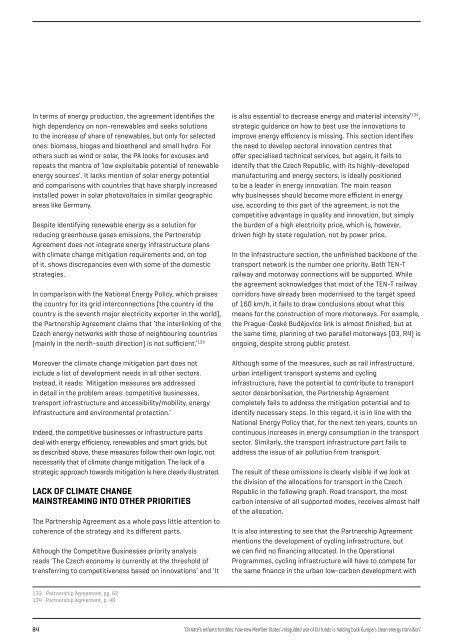ENFANTS TERRIBLES
enfants-terribles
enfants-terribles
Create successful ePaper yourself
Turn your PDF publications into a flip-book with our unique Google optimized e-Paper software.
In terms of energy production, the agreement identifies the<br />
high dependency on non-renewables and seeks solutions<br />
to the increase of share of renewables, but only for selected<br />
ones: biomass, biogas and bioethanol and small hydro. For<br />
others such as wind or solar, the PA looks for excuses and<br />
repeats the mantra of ‘low exploitable potential of renewable<br />
energy sources’. It lacks mention of solar energy potential<br />
and comparisons with countries that have sharply increased<br />
installed power in solar photovoltaics in similar geographic<br />
areas like Germany.<br />
Despite identifying renewable energy as a solution for<br />
reducing greenhouse gases emissions, the Partnership<br />
Agreement does not integrate energy infrastructure plans<br />
with climate change mitigation requirements and, on top<br />
of it, shows discrepancies even with some of the domestic<br />
strategies.<br />
In comparison with the National Energy Policy, which praises<br />
the country for its grid interconnections (the country id the<br />
country is the seventh major electricity exporter in the world),<br />
the Partnership Agreement claims that ‘the interlinking of the<br />
Czech energy networks with those of neighbouring countries<br />
(mainly in the north-south direction) is not sufficient.’ 133<br />
Moreover the climate change mitigation part does not<br />
include a list of development needs in all other sectors.<br />
Instead, it reads: ‘Mitigation measures are addressed<br />
in detail in the problem areas: competitive businesses,<br />
transport infrastructure and accessibility/mobility, energy<br />
infrastructure and environmental protection.’<br />
Indeed, the competitive businesses or infrastructure parts<br />
deal with energy efficiency, renewables and smart grids, but<br />
as described above, these measures follow their own logic, not<br />
necessarily that of climate change mitigation. The lack of a<br />
strategic approach towards mitigation is here clearly illustrated.<br />
LACK OF CLIMATE CHANGE<br />
MAINSTREAMING INTO OTHER PRIORITIES<br />
The Partnership Agreement as a whole pays little attention to<br />
coherence of the strategy and its different parts.<br />
Although the Competitive Businesses priority analysis<br />
reads ’The Czech economy is currently at the threshold of<br />
transferring to competitiveness based on innovations’ and ‘It<br />
is also essential to decrease energy and material intensity’ 134 ,<br />
strategic guidance on how to best use the innovations to<br />
improve energy efficiency is missing. This section identifies<br />
the need to develop sectoral innovation centres that<br />
offer specialised technical services, but again, it fails to<br />
identify that the Czech Republic, with its highly-developed<br />
manufacturing and energy sectors, is ideally positioned<br />
to be a leader in energy innovation. The main reason<br />
why businesses should become more efficient in energy<br />
use, according to this part of the agreement, is not the<br />
competitive advantage in quality and innovation, but simply<br />
the burden of a high electricity price, which is, however,<br />
driven high by state regulation, not by power price.<br />
In the Infrastructure section, the unfinished backbone of the<br />
transport network is the number one priority. Both TEN-T<br />
railway and motorway connections will be supported. While<br />
the agreement acknowledges that most of the TEN-T railway<br />
corridors have already been modernised to the target speed<br />
of 160 km/h, it fails to draw conclusions about what this<br />
means for the construction of more motorways. For example,<br />
the Prague-České Budějovice link is almost finished, but at<br />
the same time, planning of two parallel motorways (D3, R4) is<br />
ongoing, despite strong public protest.<br />
Although some of the measures, such as rail infrastructure,<br />
urban intelligent transport systems and cycling<br />
infrastructure, have the potential to contribute to transport<br />
sector decarbonisation, the Partnership Agreement<br />
completely fails to address the mitigation potential and to<br />
identify necessary steps. In this regard, it is in line with the<br />
National Energy Policy that, for the next ten years, counts on<br />
continuous increases in energy consumption in the transport<br />
sector. Similarly, the transport infrastructure part fails to<br />
address the issue of air pollution from transport.<br />
The result of these omissions is clearly visible if we look at<br />
the division of the allocations for transport in the Czech<br />
Republic in the following graph. Road transport, the most<br />
carbon intensive of all supported modes, receives almost half<br />
of the allocation.<br />
It is also interesting to see that the Partnership Agreement<br />
mentions the development of cycling infrastructure, but<br />
we can find no financing allocated. In the Operational<br />
Programmes, cycling infrastructure will have to compete for<br />
the same finance in the urban low-carbon development with<br />
133<br />
134<br />
Partnership Agreement, pg. 62<br />
Partnership Agreement, p. 40<br />
84<br />
‘Climate’s enfants terribles: how new Member States’ misguided use of EU funds is holding back Europe’s clean energy transition’


